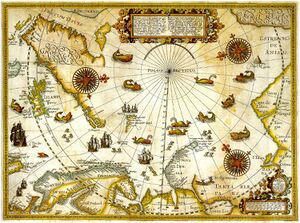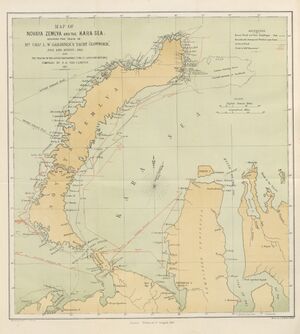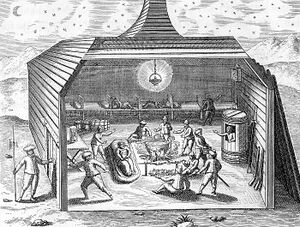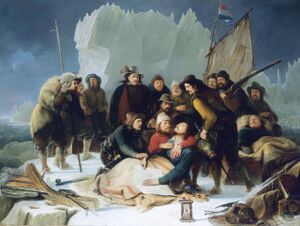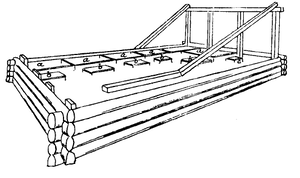ويلم بارنتس
Willem Barentsz | |
|---|---|
 Willem Barentsz | |
| وُلِدَ | ح. 1550 |
| توفي | 20 يونيو 1597 (aged 46–47) في البحر بالمنطقة القطبية |
| القومية | هولندي |
| المهنة | ملاح |
| عـُرِف بـ | استكشاف القطب الشمالي |
ويلم بارنتس (Willem Barentsz ؛ النطق الهولندي: [ˈʋɪləm ˈbaːrənts]؛ ح. 1550 – 20 يونيو 1597)، نظير اسمه الإنگليزي: William Barents أو Barentz، كان ملاحاً ورسام خرائط ومستكشف هولندي.
قام بارنتس بثلاث تجريدات استكشافية إلى أقصى الشمال بحثاً عن الممر الشمالي الشرقي. وقد وصل حتى نوڤايا زمليا وبحر كارا في رحلتيه الأولتين، ولكنه عاد في كلتاهما بسبب الجليد. وفي رحلته الثالثة، اكتشف الطاقم سپتسبرگن و جزيرة الدب، إلا أنه لاحقاً عـَلـَقَ في نوڤايا زمليا لنحو عام. توفي بارنتس في رحلة عودته سنة 1597.
بحر بارنتس، بين أماكن أخرى كثيرة، سُمِّيَ على اسمه.[1]
سيرته
حياته كمستكشف أمضاها باحثاً عن الممر الشمالي الشرقي للتجارة مع الصين.[1] لقد استنتج أن المياه المفتوحة الصافية شمال سيبيريا يجب أن تكون موجودة منذ الشمس تشرق 24 ساعة في اليوم مذيبةً جليد البحر القطبي، وفي الواقع كان يعتقد أنه كلما اتجه شمالاً كلما قل الجليد هناك.[1][2]
الرحلة الأولى
الرحلة الثانية
الرحلة الثالثة
In January 1597, the crew became the first to witness and record the atmospheric anomaly now coined the Novaya Zemlya effect, due to this sighting.[3]
Proving somewhat successful at hunting, the group caught Arctic foxes in primitive traps.[2] The raw flesh of the Artic fox contains small amounts of vitamin C, which, unknown to the sailors, reduced the effects of scurvy.[1] The crew were continually attacked by polar bears that infested the area where they camped.[1] The bears turned the stranded and now empty ship into a wintertime abode. Primitive guns usually did not kill the bears on first or even second shot (unless well aimed at the heart) and were difficult to aim, while the cold and brittle metal weapons often shattered or bent.[1]
By June, the ice had still not loosened its grip on the ship, and the remaining desperate scurvy-ridden survivors took two open boats. Barentsz died at sea soon after on 20 June 1597. It is not known whether Barentsz was buried on the northern island of Novaya Zemlya, or at sea.[4] It took seven more weeks for the boats to reach the Kola Peninsula, where they were rescued by a Dutch merchant vessel commanded by former fellow explorer Jan Rijp who by that time had returned to the Netherlands and was on a second voyage, assuming the Barentsz crew to be lost, and found it by accident.[1] By that time, only 12 crewmen remained. They did not reach Amsterdam until 1 November.[5] Sources differ on whether two men died on the ice floe and three in the boats,[2] or three on the ice floe and two in the boats.[6] The young cabin boy had died during the winter months in the shelter.[7]
الحفريات واللقى
الذكرى
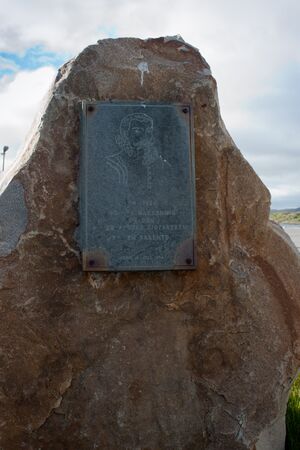
Two of Barentsz' crewmembers later published their journals, Jan Huyghen van Linschoten who had accompanied him on the first two voyages, and Gerrit de Veer who had acted as the ship's carpenter on the last two voyages.
الهامش
هذا المقال يذكر مصادره ولكنه لا يعطي رقم الصفحة. (June 2021) (Learn how and when to remove this template message) |
- ^ أ ب ت ث ج ح خ Andrea Pitzer (2021). Icebound: Shipwrecked at the Edge of the World. Scribner. ISBN 978-1982113346.
- ^ أ ب ت "God and the Arctic survivor". New Scientist. April 1993.
- ^ "Homage to Gerrit de Veer". Retrieved 7 December 2007.
- ^ "Search for Barents: Evaluation of Possible Burial Sites on North Novaya Zemlya, Russia", Jaapjan J. Zeeberg et al., Arctic Vol. 55, No. 4 (December 2002) p. 329–338
- ^ Goorich, Frank Boott. "Man Upon the Sea", 1858.
- ^ De Peyster, John Watts. The Dutch at the North pole and the Dutch in Maine. 3 March 1857.
- ^ خطأ استشهاد: وسم
<ref>غير صحيح؛ لا نص تم توفيره للمراجع المسماةdiscovery
وصلات خارجية
- Works by or about ويلم بارنتس in libraries (WorldCat catalog)
قالب:Early modern Netherlandish cartography, geography and cosmography
- Short description is different from Wikidata
- Articles lacking page references from June 2021
- مستكشفون هولنديون في القرن 16
- رسامو خرائط هولنديون في القرن 16
- هولنديو القرن 16
- مواليد عقد 1550
- وفيات 1597
- بحر بارنتس
- وفيات بالإسقربوط
- مستكشفون قطبيون هولنديون
- مستكشفو سڤالبارد
- مستكشفو القارة القطبية الشمالية
- أشخاص من ترشلنگ
- أشخاص من الجمهورية الهولندية
- رسم الخرائط الهولندي الحديث المبكر



